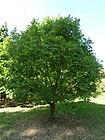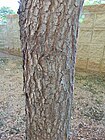Note: This is a project under development. The articles on this wiki are just being initiated and broadly incomplete. You can Help creating new pages.
Difference between revisions of "Pistacia chinensis - Chakrangi"
| (14 intermediate revisions by 3 users not shown) | |||
| Line 1: | Line 1: | ||
[[File:Pistacia chinensis.jpg|thumb|right|''Chakrangi'']] | [[File:Pistacia chinensis.jpg|thumb|right|''Chakrangi'']] | ||
'''Kakkar''' is glorious tree native to the lower Himalayan slopes, from Afghanistan to Kumaon, cultivated for its attractive leaves, which are bright red when young. | '''Kakkar''' is glorious tree native to the lower Himalayan slopes, from Afghanistan to Kumaon, cultivated for its attractive leaves, which are bright red when young. | ||
| − | |||
==Uses== | ==Uses== | ||
| − | {{Uses| | + | {{Uses|Cough}}, {{Uses|Phthisis bulbi}}, {{Uses|Asthma}}, {{Uses|Dysentery}}. |
==Parts Used== | ==Parts Used== | ||
| Line 9: | Line 8: | ||
==Chemical Composition== | ==Chemical Composition== | ||
| − | <ref name="chemical composition"/> | + | It contains α-pinene, terpinene-4-ol, β-pinene, Δ3-carene, limonene, γ-terpinene, and α-terpineol, 2-diphenyl, 1-picrylhydrazyl and ,2-azinobis.<ref name="chemical composition"/> |
==Common names== | ==Common names== | ||
| − | {{Common names|kn=Chakrangi, | + | {{Common names|kn=Chakrangi, Kaakada shringi|ml=NA|sa=Chakra, Chakrangi|ta=Kakkata-Shinigi|te=Kakarashingi, Kaakara shingi|hi=Kakra, Kakra-singi|en=Kakkar|}} |
==Properties== | ==Properties== | ||
| Line 30: | Line 29: | ||
==Habit== | ==Habit== | ||
| − | {{Habit|Deciduous | + | {{Habit|Deciduous tree}} |
==Identification== | ==Identification== | ||
===Leaf=== | ===Leaf=== | ||
| − | {{Leaf|Paripinnate| | + | {{Leaf|Paripinnate|Large up to 25 cm long|Leaves bearing 2-6 pairs of lanceolate, long leaflets. The terminal leaflet is much smaller than the lateral ones or even reduced to a mucrol}}<ref name="Leaf"/> |
===Flower=== | ===Flower=== | ||
| − | {{Flower|Unisexual|2-4cm long| | + | {{Flower|Unisexual|2-4cm long|Blue||Flowering throughout the year and In terminal and axillary pseudoracemes}} |
===Fruit=== | ===Fruit=== | ||
| − | {{Fruit| | + | {{Fruit|Globular|5-6 mm in diameter|Purplish or blue||May|Fruiting throughout the year}} |
===Other features=== | ===Other features=== | ||
==List of Ayurvedic medicine in which the herb is used== | ==List of Ayurvedic medicine in which the herb is used== | ||
| − | * [[ | + | * [[Aṣṭāṇgāvaleha]] |
==Where to get the saplings== | ==Where to get the saplings== | ||
==Mode of Propagation== | ==Mode of Propagation== | ||
| − | {{Propagation| | + | {{Propagation|Seeds}}, {{Propagation|Cuttings}} |
==How to plant/cultivate== | ==How to plant/cultivate== | ||
| − | A plant of the warm temperate to subtropical zones, just entering into the tropics in northern Myanmar. It can tolerate frosts. It prefers growing in areas with a mean annual rainfall in the region of 1,270mm<ref name="How to plant/cultivate"/> | + | A plant of the warm temperate to subtropical zones, just entering into the tropics in northern Myanmar. It can tolerate frosts. It prefers growing in areas with a mean annual rainfall in the region of 1,270mm.<ref name="How to plant/cultivate"/> |
==Commonly seen growing in areas== | ==Commonly seen growing in areas== | ||
| Line 70: | Line 69: | ||
<references> | <references> | ||
| − | <ref name="How to plant/cultivate">[http://tropical.theferns.info/viewtropical.php?id=Pistacia+integerrima | + | <ref name="How to plant/cultivate">[http://tropical.theferns.info/viewtropical.php?id=Pistacia+integerrima Cultivation Details]</ref> |
| + | <ref name="chemical composition">[https://www.tandfonline.com/doi/abs/10.1080/0972060X.2016.1174079 Constituents]</ref> | ||
| + | <ref name="Leaf">[http://jagdishrajiv.com/index1.php?c=63&p=87 Leaf]</ref> | ||
| + | |||
</references> | </references> | ||
==External Links== | ==External Links== | ||
| − | + | * [http://www.flowersofindia.net/catalog/slides/Kakkar.html Karkaataka shringi on flowersofindia.net] | |
| + | * [http://www.missouribotanicalgarden.org/PlantFinder/PlantFinderDetails.aspx?kempercode=b641 Karkaataka shringi on missouribotanicalgarden.org] | ||
[[Category:Herbs]] | [[Category:Herbs]] | ||
| + | [[Category:Ayurvedic herbs that don't have flower, fruit and leaf photos]] | ||
| + | [[Category:Ayurvedic herbs that don't have seed photos]] | ||
| + | [[Category:Anacardiaceae]] | ||
Latest revision as of 11:06, 3 July 2020
Kakkar is glorious tree native to the lower Himalayan slopes, from Afghanistan to Kumaon, cultivated for its attractive leaves, which are bright red when young.
Contents
- 1 Uses
- 2 Parts Used
- 3 Chemical Composition
- 4 Common names
- 5 Properties
- 6 Habit
- 7 Identification
- 8 List of Ayurvedic medicine in which the herb is used
- 9 Where to get the saplings
- 10 Mode of Propagation
- 11 How to plant/cultivate
- 12 Commonly seen growing in areas
- 13 Photo Gallery
- 14 References
- 15 External Links
Uses
Cough, Phthisis bulbi, Asthma, Dysentery.
Parts Used
Chemical Composition
It contains α-pinene, terpinene-4-ol, β-pinene, Δ3-carene, limonene, γ-terpinene, and α-terpineol, 2-diphenyl, 1-picrylhydrazyl and ,2-azinobis.[1]
Common names
| Language | Common name |
|---|---|
| Kannada | Chakrangi, Kaakada shringi |
| Hindi | Kakra, Kakra-singi |
| Malayalam | NA |
| Tamil | Kakkata-Shinigi |
| Telugu | Kakarashingi, Kaakara shingi |
| Marathi | NA |
| Gujarathi | NA |
| Punjabi | NA |
| Kashmiri | NA |
| Sanskrit | Chakra, Chakrangi |
| English | Kakkar |
Properties
Reference: Dravya - Substance, Rasa - Taste, Guna - Qualities, Veerya - Potency, Vipaka - Post-digesion effect, Karma - Pharmacological activity, Prabhava - Therepeutics.
Dravya
Rasa
Guna
Veerya
Vipaka
Karma
Prabhava
Habit
Identification
Leaf
| Kind | Shape | Feature |
|---|---|---|
| Paripinnate | Large up to 25 cm long | Leaves bearing 2-6 pairs of lanceolate, long leaflets. The terminal leaflet is much smaller than the lateral ones or even reduced to a mucrol |
Flower
| Type | Size | Color and composition | Stamen | More information |
|---|---|---|---|---|
| Unisexual | 2-4cm long | Blue | Flowering throughout the year and In terminal and axillary pseudoracemes |
Fruit
| Type | Size | Mass | Appearance | Seeds | More information |
|---|---|---|---|---|---|
| Globular | 5-6 mm in diameter | Purplish or blue | May | Fruiting throughout the year |
Other features
List of Ayurvedic medicine in which the herb is used
Where to get the saplings
Mode of Propagation
How to plant/cultivate
A plant of the warm temperate to subtropical zones, just entering into the tropics in northern Myanmar. It can tolerate frosts. It prefers growing in areas with a mean annual rainfall in the region of 1,270mm.[3]
Commonly seen growing in areas
Dry slopes, Valleys along rivers.
Photo Gallery
References
External Links
- Ayurvedic Herbs known to be helpful to treat Cough
- Ayurvedic Herbs known to be helpful to treat Phthisis bulbi
- Ayurvedic Herbs known to be helpful to treat Asthma
- Ayurvedic Herbs known to be helpful to treat Dysentery
- Herbs with Galls used in medicine
- Herbs with Fruits used in medicine
- Herbs with common name in Kannada
- Herbs with common name in Hindi
- Herbs with common name in Malayalam
- Herbs with common name in Tamil
- Herbs with common name in Telugu
- Herbs with common name in Sanskrit
- Herbs with common name in English
- Habit - Deciduous tree
- Index of Plants which can be propagated by Seeds
- Index of Plants which can be propagated by Cuttings
- Herbs that are commonly seen in the region of Dry slopes
- Herbs that are commonly seen in the region of Valleys along rivers
- Herbs
- Ayurvedic herbs that don't have flower, fruit and leaf photos
- Ayurvedic herbs that don't have seed photos
- Anacardiaceae





